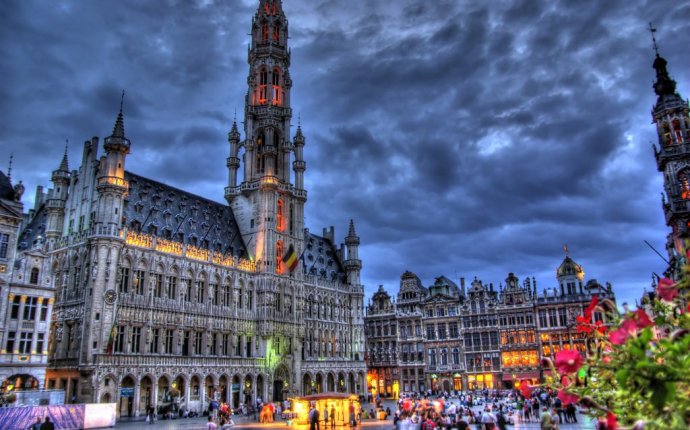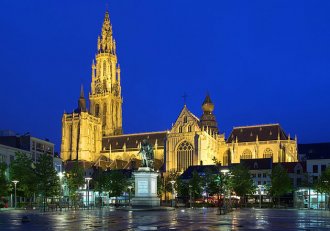
Things to Do in Antwerp, Belgium

1 Grand Place (Grote Markt)
Grand Place (Grote Markt)
Antwerp's Grand Place (Grote Markt) with its town hall and numerous guild houses is the heart of the old town. In the middle stands the ornate Brabo Fountain erected in 1887 by Jef Lambeaux and depicting the Roman soldier Silvius Brabo tossing the severed hand of the giant Antigonus into the Scheldt. The Town Hall (or Stadhuis) dominates the plaza's western side and was built by Cornelis Floris de Vriendt between 1561 and 1565. Inside, the rooms are hung with 19th-century paintings by H. Leys illustrating the history of Antwerp. Apart from the Stadhuis, most of the buildings bordering the Grote Markt are former guild houses (gildehuizen), which originally served as headquarters of the city's 16th- and 17th-century guilds. Among the most interesting guild houses on the north side are the Gildehuis der Kuipers (Coopers' House No. 5), the Huis van de Schutters (Archer's House No. 7), and the Huis van de Kruideniers (Grocers' House No. 11). Immediately behind the town hall, in the Gildekamersstraat, a former guild house has been turned into a Folk Museum devoted to the many traditional arts and crafts found in the Antwerp area, while nearby is the Ethnography Museum, which highlights non-European cultures.
 Address: Grand Place, Central Antwerp
Address: Grand Place, Central Antwerp
2 St. Paul's Church (Sint-Pauluskerk)
St. Paul's Church (Sint-Pauluskerk)
In the central city, the Veemarkt (the plaza that once functioned as a former cattle market) is home to the late Gothic St. Paul's Church (Sint-Pauluskerk), begun in 1517 and not completed until 1639. The Baroque clock tower dates from 1680. A fire in 1968 badly damaged the church and only the spirited efforts of local people prevented the loss of valuable interior furnishings. The church is home to paintings by Rubens, Jordaens, and Van Dyck. These include the superb Baroque confessionals by Pieter Verbruggen the Elder and three paintings by Rubens: The Scourging of Christ (1617) in the left aisle and the Adoration of the Shepherds and Disputation on the Blessed Sacrament in the left transept.
Address: Sint Paulusstraat 20/22, Central Antwerp
3 Cathedral of Our Lady
 The Cathedral of Our Lady (Onze Lieve Vrouwkathedraal), is Belgium's largest Gothic church. Work was started on the cathedral in 1352, continuing until 1521. Jacob van Thienen, Pieter Appelmans, Jan Tac, Everaert Spoorwater, Hermann and Dominic de Waghemakere, and Rombout Keldermans were among the architects and master-builders who contributed to its construction. The church has suffered serious damage on a number of occasions over the years, depriving it of many of its most precious works of art. First came a fire in 1533, then despoliation at the hands of dissident iconoclasts in 1566, Calvinists in 1581, and French Republican troops in 1794 and 1800. Sadly, only a few of the lost treasures have since been recovered. Restoration of the exterior was begun in the 19th century, and all the carved stonework on the outside of the building is therefore recent. Work on the interior began in 1965, starting with the nave where repairs were completed in 1983. The finest of the remaining works of art are displayed in the nave and aisles as well as in the cathedral treasury.
The Cathedral of Our Lady (Onze Lieve Vrouwkathedraal), is Belgium's largest Gothic church. Work was started on the cathedral in 1352, continuing until 1521. Jacob van Thienen, Pieter Appelmans, Jan Tac, Everaert Spoorwater, Hermann and Dominic de Waghemakere, and Rombout Keldermans were among the architects and master-builders who contributed to its construction. The church has suffered serious damage on a number of occasions over the years, depriving it of many of its most precious works of art. First came a fire in 1533, then despoliation at the hands of dissident iconoclasts in 1566, Calvinists in 1581, and French Republican troops in 1794 and 1800. Sadly, only a few of the lost treasures have since been recovered. Restoration of the exterior was begun in the 19th century, and all the carved stonework on the outside of the building is therefore recent. Work on the interior began in 1965, starting with the nave where repairs were completed in 1983. The finest of the remaining works of art are displayed in the nave and aisles as well as in the cathedral treasury.
Address: Groenplaats 21 / Handschoenmarkt, Central Antwerp
Onze Lieve Vrouwkathedraal Map
4 Butcher's Hall (Vleeshuis)
 Butcher's Hall (Vleeshuis)
Butcher's Hall (Vleeshuis)
The elegant rooms of the late Gothic Butcher's Hall (Vleeshuis) include the former council chamber of the butchers' guild. The impressive brick building, built in 1501-04, was deliberately sited close to the Scheldt, allowing the blood of slaughtered animals to run off into the river. The Vleeshuis is now a museum of applied art and archaeology with collections of prehistoric, Egyptian, Roman, and Merovingian artefacts; weapons and armour; ceramics; furniture; sculpture and woodwork; and coins. Among its most prized possessions are a 16th-century depiction of the conversion of Saul created from Antwerp tiles known as the Averbode Retable by Pieter Coecke van Aelst. The Vleeshuis is also home to an outstanding collection of musical instruments including the remarkable harpsichord from the workshop of Ruckers the instrument-makers.
Address: Vleeshouwerstraat 38-40, Central Antwerp
5 Plantin-Moretus Museum
In 1576, Christophe Plantin the printer who hailed originally from France, moved into a house he christened "De gulden Passer" - the Golden Compasses - south of the Grote Markt. The house, lived in by Plantin and his Moretus family heirs is now a supreme example of Flemish Renaissance architecture. Today, the building is the Plantin-Moretus Museum incorporating the history of printing as well as showcasing the atmosphere of an Old Flemish patrician house. The original furnishings, wide-ranging exhibits, and above all, the still tangible atmosphere arising from the proximity of home and workplace make this museum one of Antwerp's most fascinating tourist attractions. If you're short on time, make a beeline for Room 7, devoted to the history of books and the processes involved in their production, from the earliest forms of writing and development of the alphabet - exhibits include important archaeological finds and manuscripts - to Johannes Gutenberg and the invention of letterpress printing using movable type. And afterwards, don't miss Room 24, which is a celebration of the art of printing in Europe as a whole, the jewel in the crown being a 36-line Gutenberg Bible on display here.













